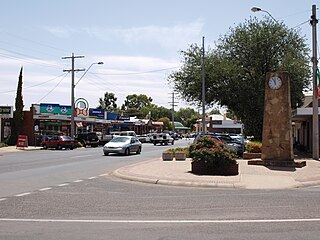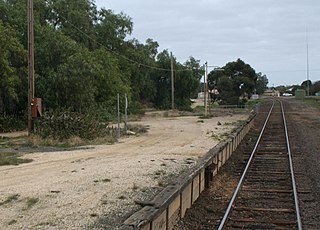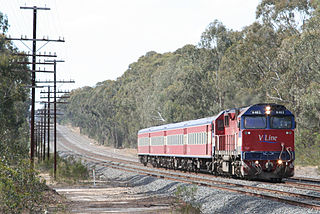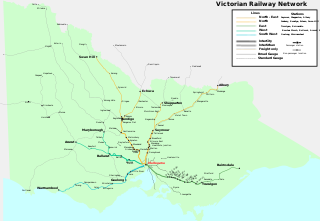
Goulburn Valley Highway is a highway located in Victoria, Australia, linking Tocumwal on the Murray River through North Central Victoria to Eildon. The section north of the Hume Freeway is part of the Melbourne to Brisbane National Highway and is the main link between these two cities, as well as a major link between Victoria and inland New South Wales. It is also the most direct route between Melbourne and the major regional centre of Shepparton in Victoria.

Strathmerton is a town in Victoria, Australia.

Cobram is a town in Victoria, Australia. It is on the Murray River which forms the border between Victoria and New South Wales. Cobram along with the nearby towns of Numurkah and Yarrawonga is part of Shire of Moira and is the administrative centre of the council. Its twin town of Barooga is located on the north side of the Murray River. Surrounding Cobram are a number of orchards, dairy farms and wineries. At the 2021 census, Cobram had a population of 6,148. Barooga's population is currently 1,888.

Numurkah is a town in Victoria, Australia, located on the Goulburn Valley Highway, 37 kilometres (23 mi) north of Shepparton, in the Shire of Moira. At the 2016 census, Numurkah had a population of 4,768.

Seymour railway station is on the Tocumwal and North East lines in Victoria, Australia. It serves the town of the same name, and opened on 20 November 1872. The station is the terminus for V/Line Seymour line services. V/Line services to Shepparton and Albury, and New South Wales XPT services to Sydney, also stop at the station.
The North East railway line is a railway line in Victoria, Australia. The line runs from Southern Cross railway station on the western edge of the Melbourne central business district to Albury railway station in the border settlement of Albury-Wodonga, serving the cities of Wangaratta and Seymour, and smaller towns in northeastern Victoria.

Shepparton railway station is located on the Tocumwal line in Victoria, Australia. It serves the city of Shepparton, and it opened on 13 January 1880.
The Tocumwal railway line is a 1,600 mm gauge railway line in Victoria, Australia. The line runs between the border town of Tocumwal in New South Wales to Southern Cross station in Melbourne. The line is used by various passenger and freight trains serving the northern suburbs of Melbourne and northern regions of Victoria.
The Strathmerton Football Netball Club, nicknamed the Bulldogs, is an Australian rules football and netball club that was established in 1894 and has been affiliated with the Picola & District Football League since 1994.

The B class are a class of diesel locomotives built by Clyde Engineering, Granville for the Victorian Railways in 1952–1953. Ordered and operated by the Victorian Railways, they initiated the dieselisation of the system and saw use on both passenger and freight services, with many remaining in service today, both in preserved and revenue service. Some were rebuilt as the V/Line A class, while others have been scrapped.

The Shire of Numurkah was a local government area on the Murray River in the Goulburn Valley region, about 210 kilometres (130 mi) north of Melbourne, the state capital of Victoria, Australia. The shire covered an area of 820 square kilometres (316.6 sq mi), and existed from 1957 until 1994.
The New Deal for Country Passengers was a timetable introduced on 4 October 1981 in Victoria, Australia which revolutionised the provision of country passenger railway services in that state. Thirty-five little-used passenger stations were closed, rolling stock utilisation was improved, and new rolling stock introduced. The timetable and associated service changes resulted in an average patronage growth of 8.7% per year, from 3 million in 1981 to 5.6 million passengers in 1990/91.

Numurkah is a closed railway station on the Goulburn Valley railway line, which once served the town of the same name, in Victoria, Australia.

Strathmerton is a closed railway station on the Goulburn Valley railway in the town of Strathmerton, Victoria, Australia. The station opened at the same time as the railway from Shepparton to Cobram on 1 October 1888, with the line to Tocumwal not opening until 28 February 1905, ending at a temporary terminus on the south side of the Murray River, the line not completed into Tocumwal until July 1908. The junction between the lines was to the north of the station, facing down trains.
Cobram railway station is a former railway station in the town of Cobram, Victoria, Australia. Passenger rail services to the station ended when V/Line ceased operating passenger services in 1993, but a number of services continued to use the line until 1999.

Hoys Roadlines was an Australian bus operator based in the Victorian city of Wangaratta. From 1993 until 2004 the company also had a contract to operate train services on the Shepparton line on behalf of the Victorian State Government.

Tocumwal railway station is a heritage-listed closed railway station in the town of Tocumwal, New South Wales, Australia. It was once the break-of-gauge between the broad gauge Victorian Railways Tocumwal line from the south, and the standard gauge New South Wales Government Railways Tocumwal line from the north. However, only the line from Victoria is still open.

The Toolamba–Echuca railway is a broad-gauge cross-country rail link between the towns of Toolamba and Echuca in Victoria, Australia. As a railway route to and from Echuca, it provides an alternative to the usual route via Bendigo. The line has not been used for passenger services since 1981, and goods movements on the line are intermittent, with it being booked out of service at times. The line was re-opened for goods traffic while there was track work on the Shepparton line between Seymour and Shepparton. On 3 October 2013 the line was re-opened after an upgrade.
The Federal District Football Association (FDFA) was first established in 1897 at a meeting at Gedye's Victoria Hotel, Cobram, Victoria for the purpose of controlling the "Cobram Courier Cup" Australian rules football competition.












